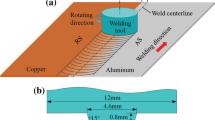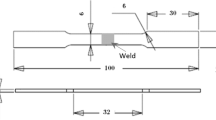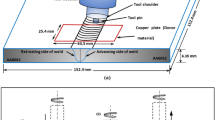Abstract
Mixing materials is essential for good strength-to-weight ratio and cost-effectiveness in industrial applications which often requires the use of hybrid materials. The Al–Cu composite is vital in applications such as transformer foil conductors, electrical connections, capacitor foil windings, and heat exchanger tubes. However, joining aluminum (Al) and copper (Cu) components through spot welding presents challenges due to their distinct properties. This study employs Friction Stir Spot Welding (FSSWP) to connect Al and Cu, examining microstructural and mechanical aspects at tool speeds from 1000 to 1500 rpm. Scanning Electron Microscopy images aid in assessing weld quality. Tensile tests on single and double spot-welded specimens reveal that the optimal tool speed is 1500 rpm, with double welds displaying 6.8% higher tensile strength and a crack-free surface. This research suggests double spot-welded specimens as a substitute for pure copper, enhancing performance. Meanwhile, in the realm of finite element analysis using Deform 3D, understanding damage in friction stir welding emphasizes the importance of rotational speed. At 1000 RPM, it influences thermal issues, material flow, and tool wear. Achieving optimal FSW results necessitates precise control, post-weld treatments, and quality management, recognizing that damage levels vary based on material, thickness, and welding conditions.











Similar content being viewed by others
Availability of data and materials
The data used to support the findings of this study are included in the article. Should further data or information be required, these are available from the corresponding author upon request.
References
Liu, H.J., Shen, J.J., Zhou, L., Zhao, Y.Q., Liu, C.: Kuang LY Microstructural characterisation and mechanical properties of friction stir welded joints of aluminium alloy to copper. Sci. Technol. Weld. Join. 16(1), 92–98 (2011)
Paidar, M., Memon, S., Samusenkov, V.O., Babaei, B., Ojo, O.O.: Friction spot extrusion welding-brazing of copper to aluminum alloy. Mater. Lett. 285, 129160 (2021)
Zhang, W., Shen, Y., Yan, Y., et al.: Microstructure characterization and mechanical behavior of dissimilar friction stir welded Al/Cu couple with different joint configurations. Int. J. Adv. Manuf. Technol. 94, 1021–1030 (2018). https://doi.org/10.1007/s00170-017-0961-2
Liu, H.J., Shen, J.J., Xie, S., Huang, Y.X., Cui, F., Liu, C., Kuang, L.Y.: Weld appearance and microstructural characteristics of friction stir butt barrier welded joints of aluminium alloy to copper. Sci. Technol. Weld. Join. 17, 104–110 (2012)
Babu, R.D., Gurusamy, P., Bejaxhin, A.B.H., Chandramohan, P.: Influences of WEDM constraints on tribological and micro structural depictions of SiC-Gr strengthened Al2219 composites. Tribol. Int. 185, 108478 (2023)
Mahesh, G., Valavan, D., Baskar, N.: A bovas herbert bejaxhin, parameter impacts of martensitic structure on tensile strength and hardness of TIG welded SS410 with characterized SEM consequences. Tehnički vjesnik 30(3), 750–759 (2023)
Prabaharan, T., Reddy, M.B.S., Bejaxhin, H.: A bovas herbert bejaxhin, strain-cum-deformation analysis of friction stir welded AA5052 and AA6061 samples with microstructural analysis. J. Mines Metals Fuels 70, 140 (2022)
Natarajan, M.M., Chinnasamy, B., Alphonse, B.H.B.: Investigation of machining parameters in thin-walled plate milling using a fixture with cylindrical support heads. Strojniški vestnik-J. Mechan. Eng. 68(12), 746–756 (2022)
Thilak, M., Jayaprakash, G., Paulraj, G., Bejaxhin, A.B., Nagaprasad, N., Buddhi, D., Gupta, M., Jule, L.T., Ramaswamy, K.: Non-traditional tolerance design techniques for low machining cost. Int. J. Interactive Design Manufact. (IJIDeM). (2023). https://doi.org/10.1007/s12008-022-00992-0
Muthu Mekala, N., Balamurugan, C., Bovas, H.B.: Deform 3D simulation and experimental investigation of fixtures with support heads. Mechanika 28(2), 130–138 (2022). https://doi.org/10.5755/j02.mech.29468
Sivagami, S.M., Bovas Herbert Bejaxhin, A., Gayathri, R., Raja Vijay, T., Punitharani, K., Keerthi Vasan, P., Meignanamoorthy, M.: On the selection of a composite material for two-wheeler foot bracket failure prevention through simulation and mathematical modeling. FDMP (2022). https://doi.org/10.3204/fdmp.2022.018752
Yadav, A., Agrawal, M., Saxena, K., Yelamasetti, B.: Numerical simulation and experimental residual stress analyses of dissimilar GTA weldments of AA 5083 and AA 6082. Int. J. Interact. Design Manufact. (IJIDeM) (2023). https://doi.org/10.1007/s12008-023-01216-9
Qin, B., Qu, R., Xie, Y., Liu, S.: Numerical simulation and experimental study on the TIG (A-TIG) welding of dissimilar magnesium alloys. Materials 15(14), 4922 (2022). https://doi.org/10.3390/ma15144922
Jaiganesh, V.: Characterization of mechanical properties and microstructural analysis of friction stir welded AZ31B Mg alloy thorough optimized process parameters. Proced. Eng. 97, 741–751 (2014). https://doi.org/10.1016/j.proeng.2014.12.304
Li, G., Zhou, L., Zhou, W., Song, X., Huang, Y.: Influence of dwell time on microstructure evolution and mechanical properties of dissimilar friction stir spot welded aluminum – copper metals. Integr. Media Res. 8, 2613–2624 (2019)
Muthu, M.F.X., Jayabalan, V.: Tool travel speed effects on the microstructure of friction stir welded aluminum-copper joints. J. Mater. Process. Technol. 217, 105–113 (2015)
Singh, H., Mehta, A., Sharma, Y., et al.: Role of expert systems to optimize the friction stir welding process parameters using numerical modelling: a review. Int. J. Interact. Des. Manuf. (2023). https://doi.org/10.1007/s12008-023-01458-7
Savolainen, K., Mononen, J., Saukkonen, T., Ha¨nninen, H.: A preliminary study on FSW of dissimilar metal joints of Cu and Al’. In: Proc. 6th Int. Symp. on ‘Friction stir welding’, Montre´al, Que., Canada, TWI, CD-ROM (2006)
Xue, P., Ni, D.R., Wang, D., Xiao, B.L., Ma, Z.Y.: Effect of friction stir welding parameters on the microstructure and mechanical properties of the dissimilar Al–Cu joints. Mater. Sci. Eng. A A528(13–14), 4683–4689 (2011)
Prasad, M.J.H., Sudhakar, I., Adinarayana, S., et al.: Simulation and validation of experimental residual stresses of dissimilar AA2124 and AA7075 TIG weld joint using ANSYS APDL. Int. J. Interact. Des. Manuf. (2023). https://doi.org/10.1007/s12008-023-01384-8
Acknowledgements
The authors appreciate the technical assistance to complete this experimental work from Department of Mechanical Engineering, Saveetha School of Engineering, SIMATS, Chennai, and Saranathan College of Engineering, Trichy, Tamil Nadu, India. The authors thank for the technical assistance to complete this experimental work.
Funding
Authors declared that no funding was received for this Research and Publication.
Author information
Authors and Affiliations
Contributions
KR—Research methodology and Novelty of the project. ABHB—Experimental and prediction outcomes. GJ—Design and Analysis, Consolidation of data and drafting. PG—Results and discussion, validation. NR—Drafting and formatting.
Corresponding author
Ethics declarations
Conflict of interest
The authors declare that there are no conflicts of interest regarding the publication of this paper.
Consent for publication
On behalf of all co-authors, hereby I understand and declare that we have authorized and participated in this journal publication regarding of identifiable details, design data, figures and tables.
Additional information
Publisher's Note
Springer Nature remains neutral with regard to jurisdictional claims in published maps and institutional affiliations.
Rights and permissions
Springer Nature or its licensor (e.g. a society or other partner) holds exclusive rights to this article under a publishing agreement with the author(s) or other rightsholder(s); author self-archiving of the accepted manuscript version of this article is solely governed by the terms of such publishing agreement and applicable law.
About this article
Cite this article
Raja, K., Bejaxhin, A.B.H., Jayaprakash, G. et al. Microstructural and mechanical analysis of achieving crack-free joints in high-speed friction stir spot welding of Cu–Al dissimilar material. Int J Interact Des Manuf (2024). https://doi.org/10.1007/s12008-024-01747-9
Received:
Accepted:
Published:
DOI: https://doi.org/10.1007/s12008-024-01747-9




